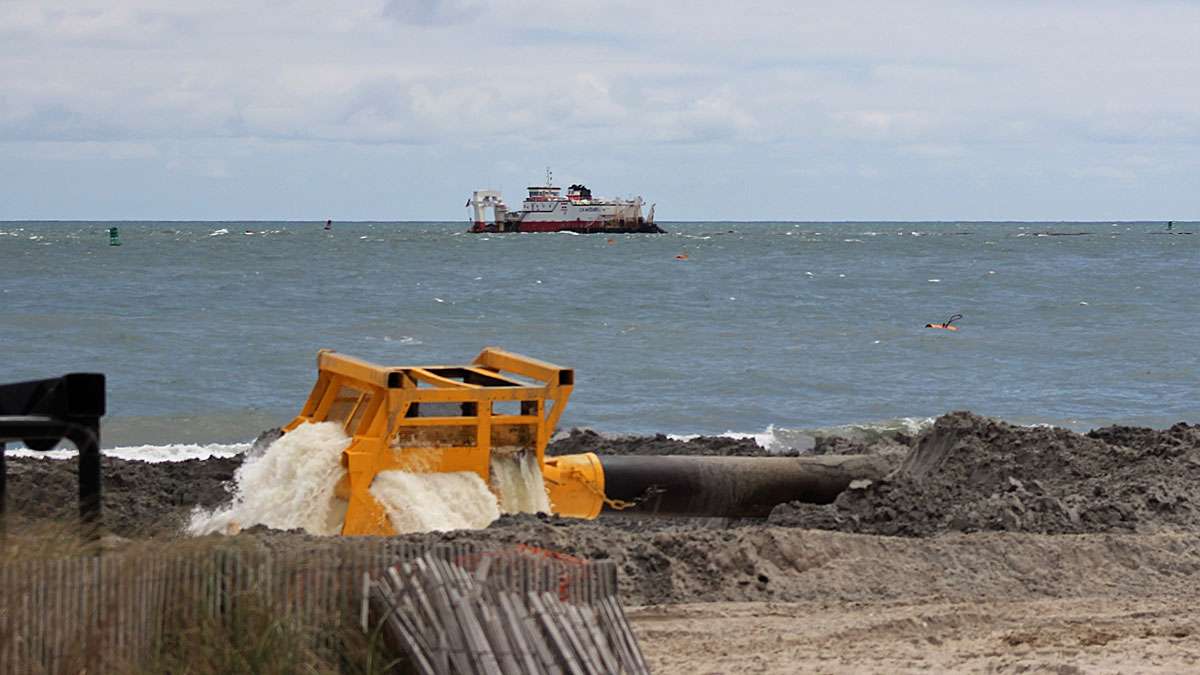Rolling beach closings planned for Absecon Island this summer
Here’s something they don’t tell you in the “DO AC” promotions for Atlantic City: This summer a federal project to build dunes will mean a series of rolling beach closings on Absecon Island, moving from north to south through the peak summer tourist season.
Army Corps Project Status updates
Track the dredging vessel’s location
Plans call for about 1,000 feet of beach to be closed for the project at a time, roughly two blocks. The work runs day and night, seven days a week through completion. That includes heavy equipment to distribute the sand, the warning beeping from that equipment backing up, and bright lights for the workers to see what they’re doing through the night. The noise, and detour for some beach-goers, may have an impact on the number of people visiting for the summer, which in turn could mean losses for businesses that rely on summer tourism. That’s almost all businesses at the shore.
Work began in the far north end of Atlantic City May 11. The Army Corps of Engineers approved a $63.3 million contract to pump sand from the inlet, north of the Boardwalk, to widen beach and create a dune system. This should help protect Atlantic City from major flooding and wave damage from storms. As the project moves farther south, a smaller dredge, known as a “hopper dredge,” will take sand from another offshore site to add to the beaches in Ventnor, Margate and Longport.
• Atlantic City – now through late July or early August
• Ventnor – early June through mid-July
• Margate – July through September
• Longport – September until November
Why now?
The Army Corps of Engineers, which is leading the project, puts the blame on Margate. Officials have said that the dune project could have been have been done by now if Margate had not tried to block it in court. “The project schedule was impacted significantly,” said Army Corps spokesman Steven Rochette. “There was a long process to give us the real estate.”
From Margate’s point of view, the dune project is not necessary. Margate Mayor Michael S. Becker says the town argued that the beachfront bulkheads provide as much protection as would sand dunes. In some instances, opposition to dune come from homeowners unhappy that their ocean views would be ruined. But Becker said he only heard one owner mention the views as a concern in the past three years. “The people felt very strongly that our bulkheads give us better protection than the dunes,” he said.
In 2014, Margate voters supported going to court to stop the dune project, and the municipal governing body decided it would not give the state and Army Corps the required easements for the work. On Nov. 24 of that year, Margate filed suit in U.S. District Court against the Army Corps of Engineers and the state Department of Environmental Protection seeking to stop the project.
In April of 2016, Judge Julio Mendez ruled that the state could seize 87 municipally-owned parcels for the work, through eminent domain. In his ruling, he found that dunes were the best, most cost-effective way to protect property and lives from coastal storms. “We took them to court to oppose it, and obviously we lost,” said Becker.
Some in Margate have suggested the summer timing for the project was payback for the attempt to stop it. “I have no way of knowing that, but we got what I expected we’d get,” said Becker.
“They have to realize that when you’re in a seashore community, you have 90 days to make a living. They could have done this in the fall, but here we are, right in the middle of summer,” said Becker.
Watching the dispute close-up
Margate’s northern neighbor Ventnor embraced the project, but will have to put up with the construction noise and beach closings in June and July just the same.
“Obviously, we’re not thrilled,” said Ventnor Commissioner Lance Landgraf.
He didn’t want to comment on Margate’s past legal action, but he says there is no question but that dunes are in everyone’s best interests. He said that was made abundantly clear during Hurricane Sandy, in which the areas of Ventnor with the strongest dune system did not get any sand or water in the street, while the areas farther south, where the dunes had been eroded, saw more damage. When this project is completed, he said, all of Absecon Island will see a benefit from the dunes.
Superstorm Sandy was the test
This point of view has the backing of studies from the Coastal Research Center at nearby Stockton University in Pomona. A 2015 report said areas with engineered dunes saw less damage during Hurricane Sandy, the massive storm that slammed New Jersey in October, 2012. The study found that the areas hit the hardest had no dunes, or small dunes.
Stewart Farrell, the founder of the Coastal Research Center, called Sandy the worst storm of the 21st century, so far, and pointed to wider beaches and dunes in Ventnor as clearly protecting that area from storm damage. Without dunes, Margate and Longport saw waves washing over the seawall in several areas during the storm, leading to extensive damage, he said.
“The argument that the Margate bulkhead exceeds or even equals a wider beach and the federal dune did not hold up to the test from Mother Nature four years ago, so my assessment is that the current project is a big improvement in shore protection for Absecon Island,” he said.
No one from Atlantic City Mayor Don Guardian’s office responded to a request for comment on this story. At the southern end of Absecon Island, Longport Mayor Nicholas Russo said there is no doubt the dunes are needed.
WHYY is your source for fact-based, in-depth journalism and information. As a nonprofit organization, we rely on financial support from readers like you. Please give today.












